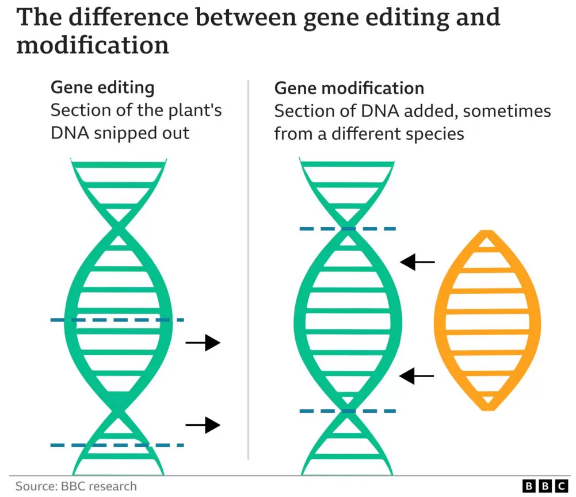Context:
Indian scientists have developed the first ever low-pungent mustard based on CRISPR/Cas9 gene editing, while being non-GM and transgene-free.
About Gene-edited Mustard:
- Gene-edited mustard refers to a variety of mustard plant that has been altered using gene editing techniques, specifically the CRISPR/Cas9 system.
CRISPR:
- CRISPR stands for “Clustered Regularly Interspaced Short Palindromic Repeats”.
- CRISPR is a gene editing technology that allows scientists to precisely modify DNA within living organisms.
Cas 9:
- Cas9 is an enzyme that acts as molecular scissors, guided by RNA molecules synthesized to match a specific DNA sequence.

|
- In this process, specific genes within the mustard plant’s DNA are modified to achieve desired traits, such as reduced pungency and increased resistance to pests and diseases.
- In it, precise changes to the existing DNA are made without introducing foreign genes from other species.
- This approach is often considered non-GMO (genetically modified organism) and transgene-free, as it involves modifying the plant’s own genetic material to achieve the desired characteristics.

How did Scientists Created this Gene-Edited Mustard?
- Scientists at the National Institute of Plant Genome Research (NIPGR) have “edited” 10 out of the 12 GTR genes in ‘Varuna’, a high-yielding Indian mustard variety.
- For this, they used CRISPR/Cas9 – a gene-editing tool deploying an enzyme, which acts as a “molecular scissors” to cut the DNA at precisely targeted locations of the gene, and then letting the natural DNA repair process take over.
- Results:
- The GTR-edited mustard contained low-seed high-leaf glucosinolates
- It showed resistance against the virulent fungal pathogen Sclerotinia sclerotiorum and the insect pest Spodoptera litura.
Benefit of Gene Edited Mustard:
- Less Pungent: Gene Edited Mustard is less pungent as normal mustard seeds have high levels of glucosinolates, a group of sulfur and nitrogen-containing compounds contributing to the characteristic pungency of their oil and meal.
- Pest and Disease Resistance: Gene-edited mustard can be engineered to be more resilient against pests and diseases, leading to increased crop yield and reduced reliance on chemical pesticides.
- Improved Shelf Life: By enhancing the plant’s natural defense mechanisms, gene-edited mustard may have a longer shelf life due to its increased resistance to spoilage organisms.
- Non-GMO Approach: Gene-edited mustard can be developed without introducing genes from unrelated organisms, which aligns with non-GMO principles and may help alleviate concerns associated with genetically modified crops.
- Import Bill of India: Edible oils imports were valued at $20.84 billion (Rs 167,270 crore) during the fiscal year ended March 2023, thus there is a need to augment domestic production.
Genetically Modified (GM) versus Gene Editing (GE)

| Aspect |
Genetically Modified (GM) |
Gene Editing (GE) |
| Source of Genes |
Foreign genes from unrelated species |
Uses the organism’s own genetic material |
| Precision |
May have variable precision in gene insertion |
Highly precise, enabling targeted changes |
| Ethical Concerns |
May involve ethical considerations related to introducing foreign genes |
Often considered more ethically acceptable due to working with the organism’s own genes |
| Ecosystem Impact |
Potential ecological impact due to introduction of foreign genes |
Lesser ecological impact as changes are made to the organism’s own genes |
| Example |
Bt Brinjal |
Gene-edited Mustard |
Rapeseed-Mustard:
- India’s most significant domestically-grown oilseed is rapeseed-mustard.
- Its share in the country’s production of vegetable oils has been estimated at 42.6% (more than soyabean’s 19.2%) and in that of meal at 30.3% (next to soyabean’s 38.9%), as per the US Department of Agriculture’s data for the marketing year ending September 2023.
Glucosinolates:
- Glucosinolates, a group of sulfur and nitrogen-containing compounds
- They are synthesized in the leaves and pod walls of mustard plants.
- Their translocation and accumulation in the seeds happens through the action of glucosinolate transporter or GTR genes.
- There are 12 such genes under two distinct classes of GTR1 and GTR2 with six copies each.
- They serve as a defense mechanism for mustard against herbivores, pests, and pathogens due to their pungent and sometimes toxic properties that deter herbivores and pests from feeding on the plants.
|
News Source: The Indian Express
![]() 22 Aug 2023
22 Aug 2023


